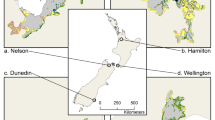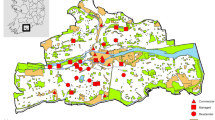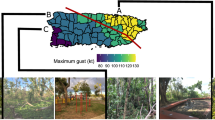Abstract
Urbanisation can be dangerous to biological diversity, but on the other hand cities can enhance local and regional biodiversity by providing habitat analogues for many – sometimes endangered – species that are elsewhere excluded from natural habitats. Sand lizards (Lacerta agilis) are endangered in Germany and populations are declining. This species may colonise urban habitats to a certain degree, but the effects of urban development or urbanisation on their distribution and population densities remain unexplained. The aim of this study was to ascertain if the metropolitan area of Berlin offers secondary habitats for sand lizard populations, which environmental factors affect colonisation success and to what degree they tolerate human impacts. In 2012, sand lizard populations in 30 plots (ten urban, ten suburban, ten rural) were assessed regarding their conservation status and environmental variables. We found 15 sand lizard populations; statistical analyses showed no significant differences in individual numbers among the three urbanisation categories. Regression models revealed that the percentage of suitable nesting sites, basking places and suitable microhabitats had a positive effect on density while individual numbers responded negatively to pets and isolation. Urbanisation neither affected sand lizard population densities nor their conservation status, and optimal habitats appeared independent of urbanisation. Urban as well as metropolitan habitats can therefore serve as refuges for this endangered species and negative impacts can be mitigated by forward-looking management, which is characterised by only minimal interventions.


Similar content being viewed by others
References
Agresti A (2002) Categorical data analysis, 2nd edn. Wiley, Hoboken
Alberti M, Marzluff JM, Shulenberger E, Bradley G, Ryan C, Zumbrunnen C (2003) Integrating humans into ecology: opportunities and challenges for studying urban ecosystems. Bioscience 53:1169–1179
Amat F, Llorente GA, Carretero MA (2013) A preliminary study on thermal ecology, activity times and microhabitat use of Lacerta agilis (Squamata: Lacertidae) in the Pyrenees. Folia Zool 52:413–422
Amt für Statistik Berlin-Brandenburg (2014) http://www.statistik-berlin-brandenburg.de. Accessed 06 Jan 2015
Berglind SA (2000) Demography and management of relict sand lizard Lacerta agilis populations on the edge of extinction. Ecol Bull 48:123–142
Bischoff W (1988) Zur Verbreitung und Systematik der Zauneidechse, Lacerta agilis Linnaeus, 1758. In: Glandt D, Bischoff W (eds) Biologie und Schutz der Zauneidechse (Lacerta agilis). Mertensiella 1:11
Blanke I (1999) Erfassung und Lebensweise der Zauneidechse (Lacerta agilis). Z Feldherpotologie 13:123–128
Blanke I (2004) Die Zauneidechse - zwischen Licht und Schatten. Z Feldherpetologie 7:160
Bosbach G, Weddeling K (2005) Zauneidechse Lacerta agilis (Linnaeus, 1758). In: Doerpinghaus A, Eichen C, Gunnermann H, Leopold P, Neukirchen M, Petermann J, Schröder E (eds) Methoden zur Erfassung von Arten der Anhänge IV und V der Flora-Fauna-Habitat-Richtlinie. Bundesamt für Naturschutz, Bonn. Naturschutz und Biologische Vielfalt 20:285–289
Carrier JA, Beebee TJC (2003) Recent, substantial, and unexplained declines of the common toad Bufo bufo in lowland England. Biol Conserv 111:395–399
Chiquet C, Dover JW, Mitchell P (2013) Birds and the urban environment: the value of green walls. Urban Ecosyst 16:453–462
Collinge SK (1996) Ecological consequences of habitat fragmentation: implications for landscape architecture and planning. Landsc Urban Plan 36:59–77
Conover WJ, Johnson ME, Johnson MM (1981) A comparative study of tests for homogeneity of variances, with applications to the outer continental shelf bidding data. Technometrics 23:351–361
De Bruyn GJ (1997) Animal communities in Dutch dunes. In: Van der Maarel E (ed) Dry coastal ecosystems: general aspects. Elsevier, Amsterdam, pp 361–386
Dearborn DC, Kark S (2009) Motivations for conserving urban biodiversity. Conserv Biol 24:1–9
Dent S, Spellenberg IF (1988) Use of forest ride verges in Southern England for the conservation of the sand lizard Lacerta agilis L. Biol Conserv 45:267–277
Dobson AJ (2002) Introduction to generalized linear models, 2nd edn. Chapman & Hall, London
DWD (2006) German Meteorological Service. http://www.dwd.de. Accessed 10 Oct 2014
Edgar P (2002) The effects of public access on amphibians and reptiles. The Herpetological Conservation Trust, Contract Number FC 73-04-145, report for the Coutryside Council for Wales, Bangor
Edgar P, Bird DR (2005) Action plan for the conservation oft he sand lizard (Lacerta agilis) in Northwest Europe. Convention on the conservation of European wildlife and nature habitats, pp 1–15
Edgar P, Foster J, Baker J (2010) Reptile habitat management handbook. Amphibian and Reptile Conservation, Bournemouth
Elbing K, Günther R, Rahmel U (1996) Zauneidechse - Lacerta agilis Linnaeus 1758. In: Günther R (ed) Die Amphibien und Reptilien Deutschlands. Fischer Verlag, Jena, pp 535–557
Ellwanger G (2004) Lacerta agilis (Linnaeus, 1758). Schriftenr Landschaftspfl Naturschutz 69:90–97
Eyre MD, Luff ML, Woodward JC (2003) Beetles (Coleoptera) on brownfield sites in England: an important conservation resource? J Insect Conserv 7:223–231
Fritz K, Sowig P (1988) Verbreitung, Habitatansprüche und Gefährdung der Zauneidechse (Lacerta agilis Linnaeus, 1758) in Baden-Württemberg. Mertensiella 1:205–214
Glandt D (1979) Beitrag zur Habitat-Ökologie von Zauneidechse (Lacerta agilis) und Waldeidechse (Lacerta vivipara) im nordwestdeutschen Tiefland, nebst Hinweisen zur Sicherung von Zauneidechsen-Beständen. Salamandra 15:13–30
Goddard MA, Dougill AJ, Benton TG (2009) Scaling up from gardens: biodiversity conservation in urban environments. Trends Ecol Evol 25:90–98
Grant BW, Middendorf G, Colgan MJ, Ahmad H, Vogel MB (2011) Ecology of urban amphibians and reptiles: urbanophiles, urbanophobes, and the urbanoblivious. In: Niemelä J, Breuste JH, Elmqvist T, Guntenspergen G, James P, McIntyre NE (eds) Urban ecology: patterns, processes, and applications. Oxford University Press, Oxford, pp 167–178
Haskins L (2000) Heathlands in an urban setting: effects of urban development on heathlands of south-east Dorset. Br Wildl 11:229–237
Haupt H (2009) Streng geschützt - nicht geschützt. Über die gerichtlich abgesicherte Vernichtung einer Zauneidechsen-Population durch die Bundesstadt Bonn. Die Eidechse 20:65–75
Heym A, Deichsel G, Hochkirch A, Veith M, Schulte U (2013) Do introduced wall lizards (Podarcis muralis) cause niche shifts in a native sand lizard (Lacerta agilis) population? A case study from south-western Germany. Salamandra 49:97–104
Hobbs RJ, Arico S, Aronson J, Baron JS, Bridgewater P, Cramer VA, Epstein PR, Ewel JJ, Klink CA, Lugo AE, Norton D, Ojima D, Richardson DM, Sanderson EW, Valladares F, Vilà M, Zamora R, Zobel M (2006) Novel ecosystems: theoretical and management aspects of the new ecological world order. Glob Ecol Biogeogr 15:1–7
Hogg JR, Nilon CH (2014) Habitat associations of birds of prey in urban business parks. Urban Ecosyst 18:267–284
Holzer KA (2014) Amphibian use of constructed and remnant wetlands in an urban landscape. Urban Ecosyst 17:955–968
House SM, Spellerberg IF (1983a) Ecology and conservation of the sand lizard (Lacerta agilis L.) habitat in southern England. J Appl Ecol 20:417–137
House SM, Spellerberg IF (1983b) Comparisons of Lacerta agilis habitats in Britain and Europe. Br J Herpetol 6:305–308
Jackson HC (1979) The decline of sand lizard Lacerta agilis L population on the sand dunes of the Merseyside coast England. Biol Conserv 16:177–193
Jellinek S, Driscoll DA, Kirkpatrick JB (2004) Environmental and vegetation variables have a greater influence than habitat fragmentation in structuring lizard communities in remnant urban bushland. Aust Ecol 29:294–304
Kowarik I (2011) Novel urban ecosystems, biodiversity, and conservation. Environ Pollut 159:1974–1983
Krone A, Kitzmann B (2006) Artenschutzmaßnahme zur Sicherung einer Zauneidechsenpopulation im Norden Berlins. Rana 7:16–22
Kühnel KD (2005) Railway tracks as habitats for the Sand Lizard (Lacerta agilis) in the urban metropolis of Berlin, Germany. In: Jung RE, Mitchell JC (eds) Urban herpetology. Herpetological Conservation 3
LANUV (Landesanstalt für Natur, Umwelt und Verbraucherschutz Nordrhein-Westfalen) (2007) ABC-Bewertung Zauneidechse NRW. Online at: http://www.naturschutzinformationen-nrw.de/artenschutz/web/babel/media/102321.pdf. Accessed 01 Oct 2014
Lundholm JT, Richardson PJ (2010) Habitat analogues for reconciliation ecology in urban and industrial environments. J Appl Ecol 47:966–975
Magle SB, Hunt VM, Vernon M, Crooks KR (2012) Urban wildlife research: past, present, and future. Biol Conserv 155:23–32
Marzluff JM (2001) Worldwide urbanization and its effects on birds. In: Marzluff JM, Bowman R, Donnelly R (eds) Avian ecology in an urbanizing world. Kluwer Academic Publishers, Leiden, pp 19–47
Mcdonald RI, Kareiva P, Forman RTT (2008) The implications of current and future urbanization for global protected areas and biodiversity conservation. Biol Conserv 141:1695–1703
McKinney LM (2002) Urbanization, biodiversity and conservation. Bioscience 52:883–890
McKinney LM (2006) Urbanization as a major cause of biotic homogenization. Biol Conserv 127:247–260
McKinney LM (2008) Effects of urbanization on species richness: a review of plants and animals. Urban Ecosyst 11:161–176
Meffert PJ, Dziock F (2012) What determines occurrence of threatened bird species on urban wastelands? Biol Conserv 153:87–96
Meffert PJ, Dziock F (2013) The influence of urbanisation on diversity and trait composition of birds. Landsc Ecol 28:943–957
Meffert PJ, Marzluff JM, Dziock F (2012) Unintentional habitats: value of a city for the wheatear (Oenanthe oenanthe). Landsc Urban Plan 108:49–56
Menke SB, Guénard B, Sexton JO, Weiser MD, Dunn RR, Silverman J (2011) Urban areas may serve as habitat and corridors for dry-adapted, heat tolerant species; an example from ants. Urban Ecosyst 14:1–29
Mutz T, Donth S (1996) Untersuchungen zur Ökologie und Populationsstruktur der Zauneidechse (Lacerta agilis) an einer Bahnlinie im Münsterland. Z Feldherpetologie 3:123–132
Nemes S, Vogrin M, Hartel T, Öllerer K (2006) Habitat selection at the sand lizard (Lacerta agilis): ontogenetic shifts. N West J Zool 2:17–26
Nicholson AM, Spellerberg IF (1989) Activity and home range of the lizard Lacerta agilis L. Herpetol J 1:362–365
R Development Core Team (2010) R: A language and environment for statistical computing. R Foundation for Statistical Computing. Online at: http://www.r-project.org
Rosenzweig ML (2003) Reconciliation ecology and the future of species diversity. Oryx 37:194–205
Rubbo MJ, Kiesecker JM (2005) Amphibian breeding distribution in an urbanized landscape. Conserv Biol 19:504–511
Rüblinger B (2009) Erfahrungen mit einer landesweiten Stichprobenkartierung von Reptilien in Hessen. Z Feldherpetologie 15:393–402
Schonert B (2009) Fang, Zwischenhälterung und Wiederaussetzung von Zauneidechsen (Lacerta agilis) im Rahmen von Verkehrsprojekten - drei Beispiele aus Berlin. Z Feldherpetologie 15:403–416
Senate Department for Urban Development (2008) Berlin Digital Environmental Atlas. Online at: http://www.stadtentwicklung.berlin.de/umwelt/umweltatlas/. Accessed 01 Oct 2014
Senate Department for Urbane Development and the Environment (2012) Berlin Environmental Atlas. 05.08 Biotope Types (Edition 2012). http://www.stadtentwicklung.berlin.de/umwelt/umweltatlas/ed508_01.htm. Accessed 29 July 2015
Shapiro SS, Wilk MB (1965) An analysis of variance test for normality (complete samples). Biometrika 52:591–611
Šidák ZK (1967) Rectangular confidence regions for the means of multivariate normal distributions. J Am Stat Assoc 62:626–633
Spellerberg IF (1988) Ecology and management of Lacerta agilis L. populations in England. Mertensiella 1:113–121
Strauss B, Biedermann R (2006) Urban brownfields as temporary habitats: driving forces for the diversity of phytophagous insects. Ecography 29:928–940
Stumpel A (1988) Habitat selection and management of the sand lizard, Lacerta agilis, L., at the Utrechtse Heuvelrug, Central Netherlands. Mertensiella 1:122–130
Stumpel AHP (2004) Reptiles and amphibians as targets for nature management. Alterra scientific contributions 13. Alterra, Wageningen
Thomas JA, Rose RJ, Clarke RT, Thomas CD, Webb NR (1999) Intraspecific variation in habitat availability among ectothermic animals near their climatic limits and their centres of range. Funct Ecol 13:55–64
Vignoli L, Mocaer I, Luiselli L, Bologna MA (2009) Can a large metropolis sustain complex herpetofauna communities? An analysis of the suitability of green space fragments in Rome. Anim Conserv 12:456–466
Williams JW, Jackson ST (2007) Novel climates, no-analog communities and ecological surprises. Front Ecol Environ 5:475–482
Wouters B, Nijssen M, Geerling G, Kleef HV, Remke E, Verberk W (2012) The effects of shifting vegetation mosaics on habitat suitability for coastal dune fauna a case study on sand lizard (Lacerta agilis). J Coast Conserv 16:89–99
Zuur AF, Leno EN, Walker NJ, Saveliev AA, Smith GM (2009) Mixed effects models and extensions in ecology with R. Springer, Berlin
Acknowledgments
We thank Jens Schirmel and two anonymous reviewers for valuable comments on the manuscript.
Author information
Authors and Affiliations
Corresponding author
Electronic supplementary material
Below is the link to the electronic supplementary material.
Appendix 1
(PDF 353 kb)
Appendix 2
(XLS 24 kb)
Rights and permissions
About this article
Cite this article
Becker, M., Buchholz, S. The sand lizard moves downtown – habitat analogues for an endangered species in a metropolitan area. Urban Ecosyst 19, 361–372 (2016). https://doi.org/10.1007/s11252-015-0497-x
Published:
Issue Date:
DOI: https://doi.org/10.1007/s11252-015-0497-x




